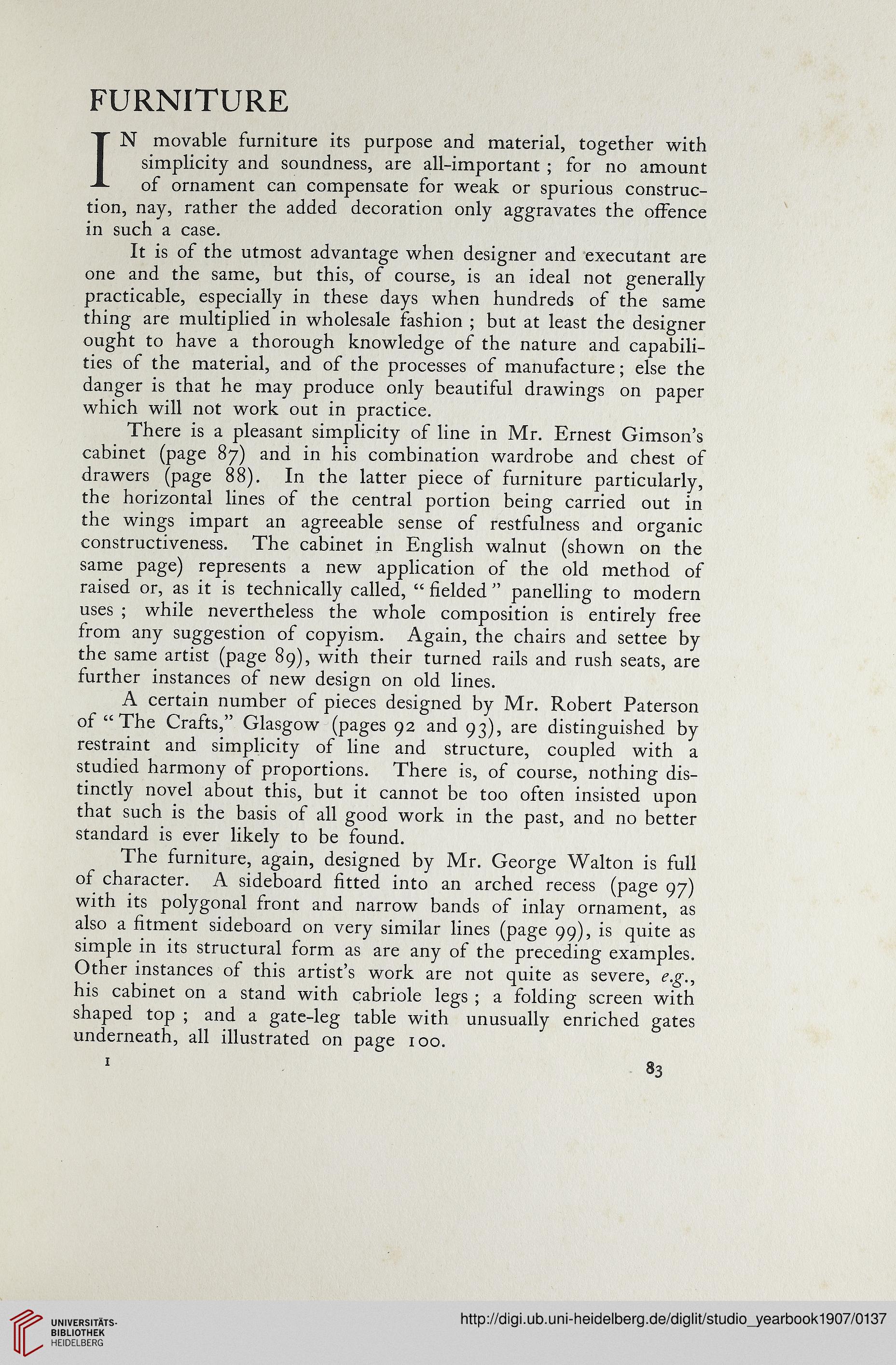FURNITURE
IN movable furniture its purpose and material, together with
simplicity and soundness, are all-important ; for no amount
of ornament can compensate for weak or spurious construc-
tion, nay, rather the added decoration only aggravates the offence
in such a case.
It is of the utmost advantage when designer and executant are
one and the same, but this, of course, is an ideal not generally
practicable, especially in these days when hundreds of the same
thing are multiplied in wholesale fashion ; but at least the designer
ought to have a thorough knowledge of the nature and capabili-
ties of the material, and of the processes of manufacture; else the
danger is that he may produce only beautiful drawings on paper
which will not work out in practice.
There is a pleasant simplicity of line in Mr. Ernest Gimson’s
cabinet (page 87) and in his combination wardrobe and chest of
drawers (page 88). In the latter piece of furniture particularly,
the horizontal lines of the central portion being carried out in
the wings impart an agreeable sense of restfulness and organic
constructiveness. The cabinet in English walnut (shown on the
same page) represents a new application of the old method of
raised or, as it is technically called, “ fielded ” panelling to modern
uses ; while nevertheless the whole composition is entirely free
from any suggestion of copyism. Again, the chairs and settee by
the same artist (page 89), with their turned rails and rush seats, are
further instances of new design on old lines.
A certain number of pieces designed by Mr. Robert Paterson
of “ The Crafts,” Glasgow (pages 92 and 93), are distinguished by
restraint and simplicity of line and structure, coupled with a
studied harmony of proportions. There is, of course, nothing dis-
tinctly novel about this, but it cannot be too often insisted upon
that such is the basis of all good work in the past, and no better
standard is ever likely to be found.
The furniture, again, designed by Mr. George Walton is full
of character. A sideboard fitted into an arched recess (page 97)
with its polygonal front and narrow bands of inlay ornament, as
also a fitment sideboard on very similar lines (page 99), is quite as
simple in its structural form as are any of the preceding examples.
Other instances of this artist’s work are not quite as severe, e.g.,
his cabinet on a stand with cabriole legs ; a folding screen with
shaped top ; and a gate-leg table with unusually enriched gates
underneath, all illustrated on page 100.
1
83
IN movable furniture its purpose and material, together with
simplicity and soundness, are all-important ; for no amount
of ornament can compensate for weak or spurious construc-
tion, nay, rather the added decoration only aggravates the offence
in such a case.
It is of the utmost advantage when designer and executant are
one and the same, but this, of course, is an ideal not generally
practicable, especially in these days when hundreds of the same
thing are multiplied in wholesale fashion ; but at least the designer
ought to have a thorough knowledge of the nature and capabili-
ties of the material, and of the processes of manufacture; else the
danger is that he may produce only beautiful drawings on paper
which will not work out in practice.
There is a pleasant simplicity of line in Mr. Ernest Gimson’s
cabinet (page 87) and in his combination wardrobe and chest of
drawers (page 88). In the latter piece of furniture particularly,
the horizontal lines of the central portion being carried out in
the wings impart an agreeable sense of restfulness and organic
constructiveness. The cabinet in English walnut (shown on the
same page) represents a new application of the old method of
raised or, as it is technically called, “ fielded ” panelling to modern
uses ; while nevertheless the whole composition is entirely free
from any suggestion of copyism. Again, the chairs and settee by
the same artist (page 89), with their turned rails and rush seats, are
further instances of new design on old lines.
A certain number of pieces designed by Mr. Robert Paterson
of “ The Crafts,” Glasgow (pages 92 and 93), are distinguished by
restraint and simplicity of line and structure, coupled with a
studied harmony of proportions. There is, of course, nothing dis-
tinctly novel about this, but it cannot be too often insisted upon
that such is the basis of all good work in the past, and no better
standard is ever likely to be found.
The furniture, again, designed by Mr. George Walton is full
of character. A sideboard fitted into an arched recess (page 97)
with its polygonal front and narrow bands of inlay ornament, as
also a fitment sideboard on very similar lines (page 99), is quite as
simple in its structural form as are any of the preceding examples.
Other instances of this artist’s work are not quite as severe, e.g.,
his cabinet on a stand with cabriole legs ; a folding screen with
shaped top ; and a gate-leg table with unusually enriched gates
underneath, all illustrated on page 100.
1
83





